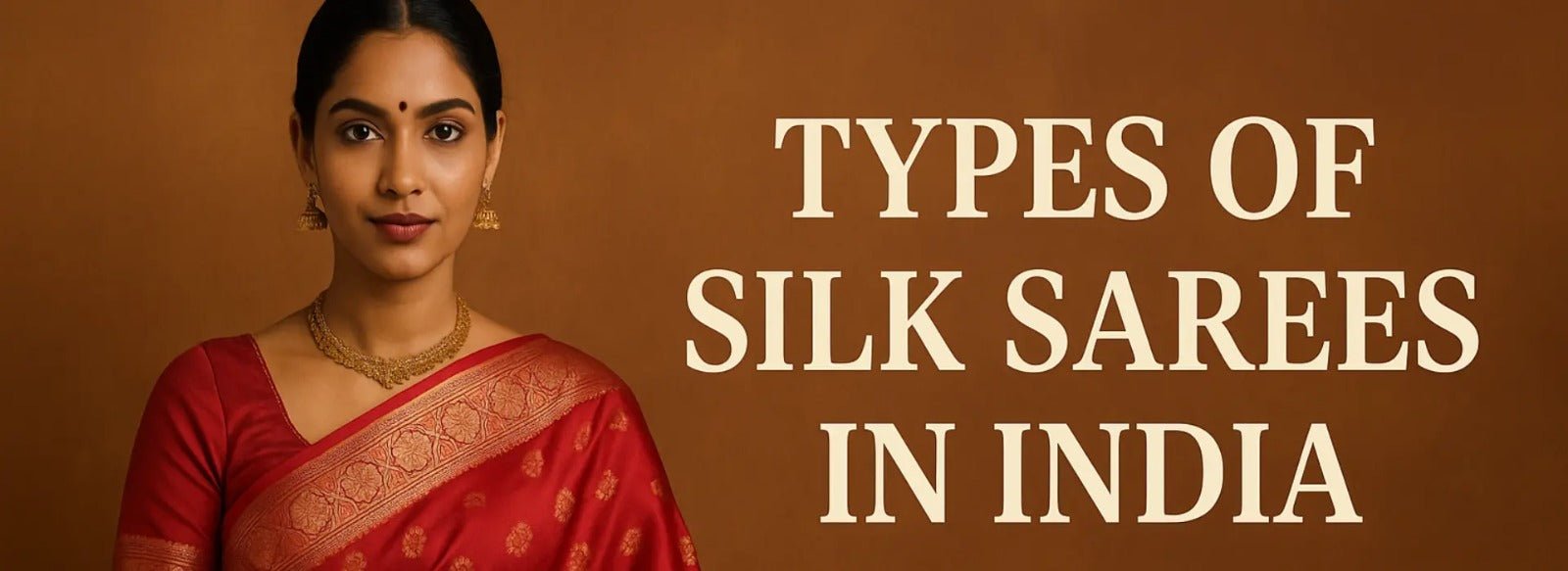Table of Contents
Silk sarees dominate Indian wardrobes for weddings, festivals, and formal occasions. Each region in India produces its variety of silk dyed with tradition and woven with cultural identity. The silk industry supports millions, from weavers in Tamil Nadu to traders in Varanasi. Today, buyers look beyond beauty—they seek stories, sustainability, and craftsmanship. Types of silk sarees you find across India, their origin, features, and why they matter.
What is a Silk Saree?

A silk saree is a six to nine-yard garment woven from silk yarns. India ranks among the top silk producers globally, with over 75% of raw silk coming from just five states—Karnataka, Andhra Pradesh, Assam, West Bengal, and Tamil Nadu. There are two main categories:
-
Pure silk sarees (often handwoven)
-
Blended or semi-silk sarees (machine or power loom-produced)
Pure silk sarees often carry a Silk Mark certification. They are durable, luxurious, and heirloom-worthy.
1. Kanjivaram Silk Saree (Tamil Nadu)
Why it stands out: Kanjivaram or Kanchipuram silk sarees use mulberry silk and real zari. The body and border are woven separately and then joined. You see bold colors, temple borders, and traditional motifs like peacocks and checks.
When to wear it: Weddings, temple functions, festive pujas.
2. Banarasi Silk Saree (Uttar Pradesh)
Why it stands out: Originating from Varanasi, these sarees use fine silk with gold and silver brocade. Intricate Mughal-inspired designs—like floral jaal, bel, and Wadhwa work—make them one of India's most luxurious weaves.
When to wear it: Bridal wear, anniversaries, big celebrations.
3. Paithani Silk Saree (Maharashtra)
Why it stands out: Paithani sarees use pure silk with zari borders and pallu featuring peacocks, lotuses, and geometrical shapes. The weaving method uses tapestry techniques and takes months.
When to wear it: Traditional Maharashtrian events, Diwali, weddings.
4. Assam Muga Silk Saree (Assam)
Why it stands out: Muga silk is golden-yellow and grows shinier with every wash. Produced from Antheraea assamensis silkworms, it's exclusive to Assam. Known for durability, it resists humidity and lasts generations.
When to wear it: Cultural functions, classical dance performances.
5. Tussar Silk Saree (Jharkhand, Bihar, Odisha, Chhattisgarh)
Why it stands out: Tussar has a textured, matte finish. It's breathable and lightweight, making it ideal for tropical climates. Tribal motifs and natural dyes enhance its raw appeal.
When to wear it: Office events, daytime functions, casual, traditional looks.

6. Mysore Silk Saree (Karnataka)
Why it stands out: Produced by Karnataka Silk Industries Corporation (KSIC), Mysore silk sarees have a smooth finish with minimal design and vibrant colors. They use pure silk and real gold zari.
When to wear it: Formal events, office parties, Navratri functions.
7. Baluchari Silk Saree (West Bengal)
Why it stands out: Baluchari sarees tell stories. Literally. Their pallus often feature mythological scenes—Krishna, Mahabharata episodes—woven in rich silk and meenakari work.
When to wear it: Durga Puja, art festivals, gifting.
8. Chanderi Silk Saree (Madhya Pradesh)
Why it stands out: A silk and cotton mix gives Chanderi sarees a sheer texture and glossy transparency. The motifs—coin, floral, and peacock—add elegance without weight.
When to wear it: Summer weddings, day ceremonies, casual celebrations.
9. Patola Silk Saree (Gujarat)
It stands out: Patola is a double ikat silk weave from Patan, Gujarat. It uses resist-dyeing techniques and symmetrical geometric or animal motifs. The process is so complex that a single saree can take months.
When to wear it: High-profile cultural events, weddings, gifting heirlooms.
10. Dharmavaram Silk Saree (Andhra Pradesh)
Why it stands out: These sarees resemble Kanjivaram with broader borders and muted colors. Often used in Bharatanatyam costumes, they blend religious symbolism with artistic richness.
When to wear it: Classical dance shows, South Indian weddings.
Why Silk Sarees Are Still Relevant
-
Sustainability: Handloom silk supports rural artisans and uses less energy than powerloom.
-
Resale Value: Pure silk sarees appreciate value and can be resold or repurposed.
-
Heritage: Every silk weave tells a story—from royal patronage to tribal expressions.
-
Versatility: From bridal to office wear, silk adapts to purpose and season.
Tips to Identify Pure Silk Sarees
-
Burn test (not advisable at home): Real silk burns with the smell of burnt hair and turns to ash.
-
Price tag: Pure silk costs more—especially with real zari.
-
Silk Mark: Check for certification by the Silk Mark Organisation of India.
-
Touch test: Pure silk feels warm and smooth; artificial silk feels cold.
India's types of silk sarees span geography, culture, and generations. Whether you want to start a collection, gift heritage, or make sustainable fashion choices, silk sarees offer timeless options. Know your weave. Support your weaver. Wear your story.
FAQs – Types of Silk Sarees in India
Q1: Which is the most expensive silk saree in India?
A: Patola and Kanjivaram sarees rank among the most expensive due to their handwoven techniques and real zari.
Q2: Which silk saree is best for weddings?
A: Banarasi, Kanjivaram, and Paithani sarees are popular bridal choices across India.
Q3: How can I buy authentic silk sarees online?
A: Look for trusted websites' customer reviews and ensure they provide Silk Mark certification.
Q4: Are silk sarees suitable for summer?
A: Tussar and Chanderi silk sarees are lightweight and breathable, perfect for warmer weather




